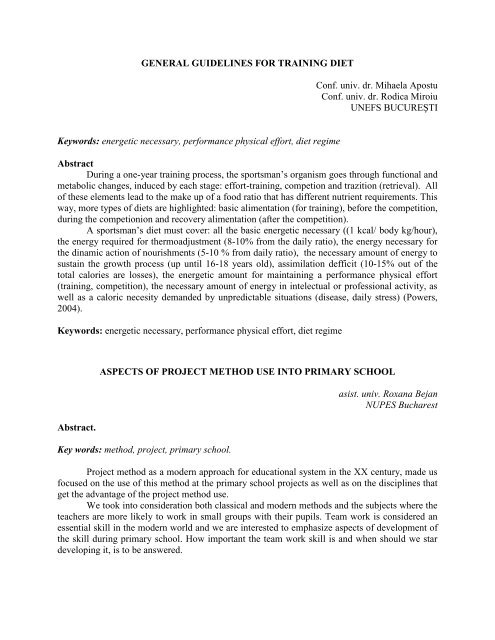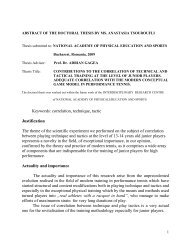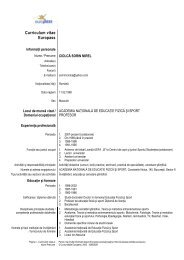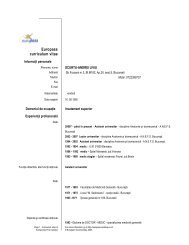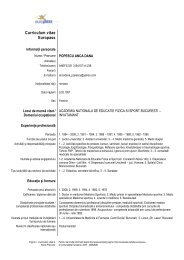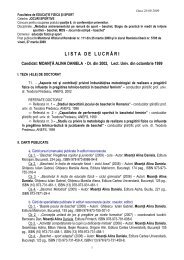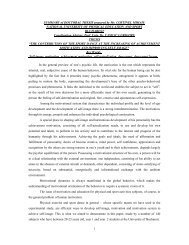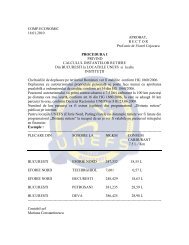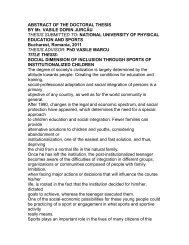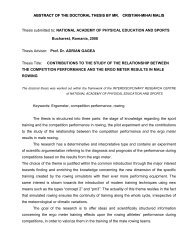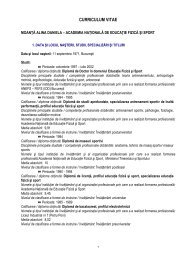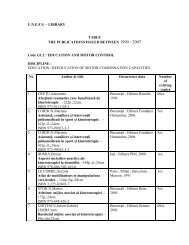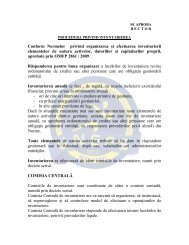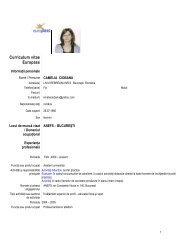GENERAL GUIDELINES FOR TRAINING DIET Conf. univ. dr - unefs
GENERAL GUIDELINES FOR TRAINING DIET Conf. univ. dr - unefs
GENERAL GUIDELINES FOR TRAINING DIET Conf. univ. dr - unefs
Create successful ePaper yourself
Turn your PDF publications into a flip-book with our unique Google optimized e-Paper software.
<strong>GENERAL</strong> <strong>GUIDELINES</strong> <strong>FOR</strong> <strong>TRAINING</strong> <strong>DIET</strong><br />
Keywords: energetic necessary, performance physical effort, diet regime<br />
<strong>Conf</strong>. <strong>univ</strong>. <strong>dr</strong>. Mihaela Apostu<br />
<strong>Conf</strong>. <strong>univ</strong>. <strong>dr</strong>. Rodica Miroiu<br />
UNEFS BUCUREŞTI<br />
Abstract<br />
During a one-year training process, the sportsman’s organism goes through functional and<br />
metabolic changes, induced by each stage: effort-training, competion and trazition (retrieval). All<br />
of these elements lead to the make up of a food ratio that has different nutrient requirements. This<br />
way, more types of diets are highlighted: basic alimentation (for training), before the competition,<br />
during the competionion and recovery alimentation (after the competition).<br />
A sportsman’s diet must cover: all the basic energetic necessary ((1 kcal/ body kg/hour),<br />
the energy required for thermoadjustment (8-10% from the daily ratio), the energy necessary for<br />
the dinamic action of nourishments (5-10 % from daily ratio), the necessary amount of energy to<br />
sustain the growth process (up until 16-18 years old), assimilation defficit (10-15% out of the<br />
total calories are losses), the energetic amount for maintaining a performance physical effort<br />
(training, competition), the necessary amount of energy in intelectual or professional activity, as<br />
well as a caloric necesity demanded by unpredictable situations (disease, daily stress) (Powers,<br />
2004).<br />
Keywords: energetic necessary, performance physical effort, diet regime<br />
Abstract.<br />
ASPECTS OF PROJECT METHOD USE INTO PRIMARY SCHOOL<br />
Key words: method, project, primary school.<br />
asist. <strong>univ</strong>. Roxana Bejan<br />
NUPES Bucharest<br />
Project method as a modern approach for educational system in the XX century, made us<br />
focused on the use of this method at the primary school projects as well as on the disciplines that<br />
get the advantage of the project method use.<br />
We took into consideration both classical and modern methods and the subjects where the<br />
teachers are more likely to work in small groups with their pupils. Team work is considered an<br />
essential skill in the modern world and we are interested to emphasize aspects of development of<br />
the skill during primary school. How important the team work skill is and when should we star<br />
developing it, is to be answered.
THE OBESITY – EPIDEMY OF XXI CENTURY<br />
Keywords: obesity, BMI, metabolic syn<strong>dr</strong>ome<br />
Asist. <strong>univ</strong>. <strong>dr</strong>d. Camelia Ciobanu<br />
NUPES Bucharest<br />
Over the recent years, obesity has become a major concern and a subject of increased attention in<br />
the countries with high living standard, because it has an increased frequency and may cause<br />
negative consequences, significantly more common among obese individuals compared to<br />
normal ones.<br />
Obesity has become a public health problem in Europe and the USA. Currently, about 43%<br />
of the world has a certain level of obesity. The risks are very high: obesity shortens life by 15-20<br />
years because of negative consequences it may cause.<br />
Only 30% of obese reach the age of 70 years as statistics indicate.A paper published by LJ from<br />
Dublin prove that mortality increases with overweight.<br />
Clinical studies confirmes that some diseases have a predilection among obese people. These<br />
include hypertension, cardiac insufficiency, angina pectoris and arthroscleroses, varicose veins,<br />
diabetes, arthritis, gall stones, emphysema and respiratory insufficiency, hepatic insufficiency,<br />
pregnancy complications etc.<br />
Obesity can be described as the most common nutritional disorder. Obesity is a condition<br />
in which excessive fat accumulates in the body, either because of higher food consumption than<br />
physiological needs, either because of metabolic disorders. Thus, an excess of 50 calories a day<br />
can increase weight by 25 pounds in a period of 10 years. The body needs energy to function<br />
normally, but maintaining a constant weight requires a balance between calorie intake and<br />
burning them. When the number of calories consumed exceeds the number of calories used by<br />
the body, is an energy imbalance, followed by weight gain and even obesity.<br />
BMI is body mass index and is an objective evaluator of normal weight according to height.<br />
A healthy weight is one that puts your body mass index (calculated based on weight and height)<br />
between 18.5 and 24.9 values - the range set by the World Health Organization.<br />
Body Mass Index (BMI) is calculated by:<br />
BMI = weight (kg) / Height2 (cm)<br />
BMI 40 = morbidly obese<br />
Conclusions:<br />
Obesity is an alarming phenomenon, with real consequences for human health, and there is a<br />
need for a wide range of environmental policies and strategies that can help people adopt healthy<br />
behaviors, such as the right to be physically active and the right to eat.<br />
Bibliografie<br />
Adam C, Chaput M, Cum sa ai un abdomen plat. Edituta Humanitas, 2009<br />
Atkinson B, Obezitatea intrea a fi si nu a fi. Editura Alex-Alex 2001<br />
Holford P, Cartea nutriției optime. Editura Bic All, 2008
Melissa Hall., Slăbim mâncând normal. Edit.Alex- Alex, București, 2007<br />
http://www.sfatulmedicului.ro/Sanatate-prin-sport/motive-pentru-o-viataactiva_1592#Obezitate_alimentatie_si_sedentarism_exista_vreo_legatura63<br />
http://dieta.romedic.ro/diete/Obezitatea_0618/Cauze_si_factori_de_risc_01830.html<br />
HOLLAND’S INVENTORY OF INTERESTS - USEFUL TOOL <strong>FOR</strong> CAREER<br />
DECISION<br />
Ph. D. Ciolcă Corina, Ph.D. Student Vasiliu Ana-Maria,<br />
NUPES Bucharest<br />
School Counselor Bratu GetaValentina<br />
Keywords: career counseling, interest, aptitude, personality types.<br />
Taking a career decision appears to be a difficult step for young people who are facing<br />
more and more career options. This is where the contribution of career counselor takes part, using<br />
numerous methods that can help young people choose the right profession for them.<br />
Knowing the personality of students is made by adding the data about the student from many<br />
environments: family, school, group of friends. Students' personality may be revealed through<br />
several methods: observation (spontaneous remark and systematic observation), the analysis of<br />
the results of the students’ work (school performance, the different products they make),<br />
conversation, questionnaire, analysis of biographical data (comparing personality features<br />
through the knowledge of the conditions in which students develop), self-characterization<br />
(emitting judgments of value about themselves), the method of socio-metrical tests.<br />
Inventories developed by Holland (Vocational Preference Inventory VPI professional preferences<br />
and SDS Self-Directed Search were published in 1966 and improved in the coming years and.<br />
The individual's personality, interests and attitudes make up a path of its orientation of his<br />
professional career.<br />
The theory developed by Holland is based on the fact that people who have similar interests will<br />
be successful in occupations that match a certain type of personality. Each respondent can find<br />
occupations that match in all six categories (Realistic, Investigative, Artistic, Social, Enterprising,<br />
Conventional), but will be particularly <strong>dr</strong>awn to two or three areas. This provides Holland code.<br />
This typology helps young people who are in a position to choose a career.<br />
The career counselor is responsible to create and implement career counseling programs designed<br />
to facilitate the process of taking the right career decision for young people considering the<br />
interests and skills that they have. It is necessary an efficient partnership between family, school<br />
and community to support young people faced with choosing a school, a profile, an <strong>univ</strong>ersity, a<br />
profession.<br />
The more a young person is best suited for a profession, his professional satisfaction will<br />
be greater and he will be more effective in the activities he performs.<br />
The Inventory developed by Holland is also useful when someone wants to change his<br />
profession and his career counselor has to recommend him other appropriate professions suited to<br />
his personal code. Being a tool easy to apply, the Inventory developed by Holland proves to be an<br />
effective tool in students' career orientation and should be used in every school
SCHOOL SPORTS FEDERATION IN ROMANIA<br />
- NECESSITY OF INTERNATIONAL<br />
ACHIEVEMENT OF SCHOOL SPORTS ACTIVITIES<br />
Creanga Emil<br />
- main teacher at Ion Creanga Technical College,<br />
- PhD Student, IInd year, UNEFS Bucharest.<br />
There have been founded many Centers of Excellence for many sports branches and they<br />
now function within educational institutions which are valuable for the area they are part of.<br />
All the sportsmen sign contracts with the Center of Excellence and are temporarily<br />
transferred to these centers with the right to play for the teams which promoted them towards the<br />
centers, within any period of the year, based on the request of the clubs and the family’s<br />
approval.<br />
The preparation within these centers is translated into the participation in the activities<br />
organized by the International Federation of School Sports (ISF) which are considered as World<br />
School Championships, where all the national sports schools meet to fight for the title of world<br />
champion.<br />
Unfortunately, Romanian school sports have been missing these competitions for many<br />
years, but lately, there have been made efforts to re-integrate the Romanian school sports in the<br />
International Federation of School Sports and the Romanian students have already participated,<br />
boys and girls, in The World School Handball Championship in 2010, in Portugal together with<br />
twenty-three other teams from all over the world, and in the World School Cross Championship<br />
in Slovakia together with other thirty countries<br />
We are sure that in the following period all the people will become aware of the necessity<br />
of our participation in this type of competitions because we, as nation, have much to say related<br />
to sports and we usually get respected by the other competitors when competing.<br />
All in all, we consider very important to create the Centers of Excellence in Sports with a<br />
long tradition in Romania and which have proven our qualities in time.<br />
ET L’IMPORTANCE DE LA COÉSION DES GROUPES EXTRASCOLAIRES<br />
Cristea Dana Ioana, Lect.<strong>univ</strong>.<strong>dr</strong>.<br />
Facultatea de Educaţie Fizică şi Sport, Universitatea din Oradea<br />
Résumé<br />
Les activités extrascolaires -le scoutisme - déroulées de maniére organisée aussi bien en<br />
plein air, en nature, que dans des espaces clos emmenagés, engen<strong>dr</strong>ent un comportement bien<br />
déterminé, qui constitue, plus exactement, le résultat des provocations inhérentes des ces<br />
activités, lesquelles présentent un grand impact non seulement sur le développement<br />
biopsychosocial, mais aussi sur la personnalité des jeunes.<br />
Les recherches sociologiques se penchent de plus en plus sur le microsocial et, surtout, sur le<br />
petit groupe. Les attitudes, les représentations que les uns se sont faites sur les autres<br />
(premièrement celles de ceux qui travaillent ensemble), les solidarités et les sympathies jouent
un rôle essentiel. L’état psychique de chaque membre de l’organisation est plus ou moins<br />
influencé par le climat psychosocial de l’organisation, ce qui emporte satisfaction ou<br />
insatisfaction, équilibre ou conflits, efficacité ou inefficacité. A part les études de sociologie, les<br />
études du domaine de la psychologie organisationnelle accordent une importance toute<br />
particulière au phénomène de la coésion, en appréciant que celle-ci présente des implications<br />
majeures sur le comportement des individus dans les groupes de travail. Notre étude se propose<br />
de metre en évidence la coésion des groupes et les influences produites à l’intérieur du groupe<br />
des scoutes Orionins d’Oradea.<br />
SPORT ICON IN WRITTEN PRESS<br />
Keywords: newspapers, news, sports, football, handball<br />
Croitoru Doina, NUPES Bucharest<br />
Abstract: The study consisted of a survey aimed at quantifying and assessing all of sports<br />
occurred in five of the most widely read newspaper in Bucharest. We wanted to target how media<br />
constructs the image, the sport enjoying a higher degree of attention, the information appears<br />
about the world of sport. The study was conducted in a period coinciding with the participation of<br />
a Romanian team in an important international competition<br />
We assume that the presence of Romanian team in a major competition will ensure that a high<br />
profile sports industry in print. We expect this picture to be quite well defined, considering the<br />
research has been conducted, a period coinciding with the tournament's final World Cup women's<br />
handball.<br />
The total number of articles that have been the subject of our research, a percentage of 86.38%<br />
consisted of football with news that "reason", the rest being shared by other sports news. I found<br />
that I ranked handball, with a rate of 5.63%, in other sports category. We believe that this is<br />
disappointing considering the percentage of ongoing research.<br />
To further assess the quality of sports news we started to calculate what percentage of total<br />
football is really news sports news. The results were as follows: 42.25% football sports news and<br />
the rest more than half, 57.74% gossip. The only conclusion we can <strong>dr</strong>aw from this part of our<br />
research is that no competition in any sport, will fail to break the mundane world football<br />
supremacy.<br />
MARKETING TOOLS USED IN HUMAN RESOURCES MANAGEMENT <strong>FOR</strong> SPORTS<br />
<strong>Conf</strong>.<strong>univ</strong>.<strong>dr</strong>. Mirela Dan<br />
Lect.<strong>univ</strong>.<strong>dr</strong>d. Corina Dulceanu<br />
Prep.<strong>univ</strong>.<strong>dr</strong>d. Ioan-Cosmin Boca<br />
“Vasile Goldiş” West University of Arad<br />
Abstract<br />
Key words: marketing, sports consumers, events, sports services
Abstract: Sports progresses together with the society, is even a mirror of it, reflecting through<br />
certain shapes the historical, social & cultural and economic evolution of the society. Sports have<br />
been sold for centuries, the role of athlete, sponsor, watcher and broadcaster existing, with other<br />
names and maybe other means, since the Antic Olympic Games. But only in the last decades has<br />
been raised the issue of an existing rationale approach system, through marketing, a complex<br />
relationship between sports consumers and products, events and sports services.<br />
ALTERNATIVES <strong>FOR</strong> A HEALTHY LIFESTYLE<br />
Abstract<br />
Keywords: the project, obesity, healthy, lifestyle<br />
Professor Tatiana Dobrescu, PhD.<br />
„Vasile Alecsan<strong>dr</strong>i” University of Bacău,<br />
Faculty of Movement, Sport and Health Science<br />
Obesity, this disease of the century, should lead toward immediate measures of reducing<br />
the number of calories we consume, toward a rational life, exercising, being aware that a normal<br />
weight means health and beauty. . (Peretianu D., Poiana C., 2009) "Alternatives for a healthy<br />
lifestyle" is a project initiated by the Faculty of Movement, Sports, and Health Sciences, of the<br />
"Vasile Alecsan<strong>dr</strong>i" University of Bacau, and Arena Fitness Club, of Bacau, in order to celebrate<br />
the EUROPEAN OBESITY DAY. The aim of this project is to popularize the methods and<br />
means of Physical Education and Sports, with the help of which everyone can change their<br />
lifestyle, or can help prevent or improve the weight excess. The objective of this initiative is to<br />
help the overweight and obese people, to help them change their lifestyle in order for them to be<br />
able to control their weight and to improve their lives.<br />
This project wants to be a part of the EOD by initiating different activities through which<br />
it can contribute to a better knowledge of the obesity problem in Romania.<br />
The role of exercise and eating control is a priority for both genders in weight control.<br />
CONTRIBUTIONS TO THE OPTIMISATION LEVEL OF SELF-CONSCIOUSNESS OF<br />
THE STUDENTS OF THE POLYTECHNIC UNIVERSITY OF BUCHAREST<br />
Drăgulin Ileana, conf. <strong>univ</strong>. <strong>dr</strong>.<br />
Liliana Becea, conf. <strong>univ</strong>. <strong>dr</strong>.<br />
Universitatea Politehnica din Bucureşti<br />
At the age of adolescence and youth, the formation of self-consciousness has an important<br />
effect on the person's quality, the person's affirmation, the psychological balance and harmony.<br />
Especially in the case of young women, life quality and social relations are strongly influenced<br />
by one's self image.<br />
Moreover, the activities performed collectively cover the the students' apartenence sphere<br />
to the social and community medium, but also represents activities students want to perform to<br />
achieve goals, wishes and personal aspirations.
Self-consciousness, an element with a defining importance in developing the personality<br />
and in the persons' social integration represents, in a general sense, the real expression of selfimage,<br />
or self-representation. This image is contaminated by wishes, but also by the way in<br />
which others evaluate the respective person, and the living identity.<br />
THE PARTICIPANT COUNTRIES AT THE WINTER OLYMPIC GAMES CLASSIFIED<br />
ON THE FIRST THREE PLACES IN THE WORLD HIERARCHY AND THE<br />
MEDALS GAINED BETWEEN 1924-2010<br />
Enache Roxana -University Professor Ph.D.<br />
Petroleum-Gas University Ploieşti<br />
Lupu Elena-University Lecturer Ph.D.<br />
Petroleum-Gas University Ploieşti<br />
Keywords: Winter Olympic Games, participant countries, study, gained medals, hierarchy.<br />
The Winter Olympics Games, define a white sporting event, held every four years.Time<br />
tradition required that, "The Summer Olympics" should be held in the same year as "The Winter<br />
Olympics", which is why the International Olympic Committee (IOC) has decided to delay the<br />
latter by two years, at the summer mid-cycle. This decision has been made in order to provide an<br />
alternation between the Summer Olympics and the Winter Olympics, and a cyclic sequence of<br />
their succession, while respecting the Olympic cycle of four years for each of them.<br />
The study undertaken regarding this issue - gaining medals "Gold, silver, and bronze at<br />
the Winter Olympic Games, from 1924 to 2010", is more informative - and not researching<br />
regarding the countries which, starting with the year 1924 - the starting year for the "Winter<br />
Olympisc", have been classified on places I, II, III, and gained gold, silver and bronze medals.<br />
DES SOLUTION POUR L’ACCROISSEMENT DE LA QUALITE DU PROCESSUS<br />
DIDACTIQUE A L’EDUCATION PHYSIQUE ET SPORTIVE A L’UNIVERSITE DU<br />
BUCAREST<br />
<strong>Conf</strong>. <strong>univ</strong>. <strong>dr</strong>. Mihaela Ganciu<br />
Université du Bucarest<br />
DES MOTS-CLE:processus didactique; qualité; éducation physique et sportive<br />
Introduction<br />
La préocupation pour la qualité représent le leitmotiv de la société actuelle, de sorte que l’<br />
intérêt de mésurer, de quantifier, d’ aprécier se généralise.<br />
Avant d’entrepren<strong>dr</strong>e des études scientifiques qui puissent identifier clairement ce que<br />
c’est qu une élite intellectuelle , les gens ont ressenti le besoin d exprimer leur estime envers les<br />
individus qui se distinguaient des autres par leurs connaissances ; c’est ainsi qu ils ont exprimé<br />
leurs impressions sous la forme des maximes.
Le concept d’ élite intellectuelle est lié au pouvoir culturelle entendue comme le niveau de<br />
la scolarité .Au délà des caractéristiques de chaque époque historique et des critères pour<br />
apprécier l élite -du prestige (G Moscq) , de l’excellence (C Cretu) , du status social (C W Mils)<br />
les personnes les plus valeureux d’une communauté sont les diplômés de l’ enseignement<br />
supérieur . D’autant plus c’est justifiée la préoccupation d’ identifier la qualité des professeurs<br />
qui préparent la population.<br />
Bibliografie :<br />
- JINGA I. 1993 Conducerea invatamantului ,Ed. didactica si Pedagocica<br />
- RADU I.T. 2000, Evaluarea in procesul didactic, Ed. Universitatii dinBucuresti<br />
- VICTORITA TRIF 2007, Evaluarea personalului didactic din invatamantul superior :<br />
un model posibil. , Ed. Universitatii dinBucuresti<br />
THE PARENTAL MODEL AND ITS INFLUENCE ON YOUNG PUPIL’S SOCIABILITY<br />
DEGREE<br />
Key words: parental style, sociability, young pupil.<br />
Primary School Teacher, Florentina HRIŢAC<br />
“Mihail Kogalniceanu” Theoretical High-School, CONSTANŢA<br />
This paper has as an aim the determination of the manner in which the parental style<br />
influences the chil<strong>dr</strong>en's sociability degree. For this, 52 pupils from the 4 th grade and their parents<br />
(104) were submitted to psychological tests.<br />
The results proved that the authorized parental style is associated with a high degree of<br />
sociability of the pupils in 4 th grade.<br />
Conclusions<br />
The results obtained after the application of the tests allowed us to elaborate the following<br />
conclusions:<br />
1. The most favorable one for the development of the young pupil’s sociability is the<br />
authorized style, followed as balance by the permissive one, the authoritative one being<br />
situated at the end.<br />
2. The pupils who are better integrated in the class team come from families who promote an<br />
educational climate which is favorable to their development, by comparison with the<br />
pupils whose parents do not favor propitious educational climate, and who demonstrate a<br />
weaker integration at the group level.<br />
Bibliography<br />
1. Balson, M., Becoming better parents. 4 th ed. Melbourne: ACER, 1994.<br />
2. Barakat, I.S., & Clark, J.A., Positive discipline and child guidance, 1999. [on-line].<br />
Accesabil la WWW:<br />
http://muextension.missouri.edu/xplor/hesguide/humanrel/gh6119.htm[25.3.2000].
3. Baumrind, D., Current patterns of parental authority. Developmental Phychology, 1971,<br />
4(1), 2-4.<br />
4. Bornstein, M.H. (n.d.)., Refocusing on parenting [on-line]. Available WWW:<br />
http://parenthood.library.wisc.edu/Bornstein/Bornstein.html<br />
[26.3.2000]<br />
REGRESSION ET PROGRÈS CHEZ LES ATHLÈTES VÉTÉRANS<br />
Corina Ivan, Maître de conférences Dr. - UNEFS<br />
Les athlètes vétérans sont atypiques par rapport à la plupart des adultes sédentaires, qui<br />
affichent un déclin physiologique énorme à partir de la seconde moitié de la vie. Leur corps subit<br />
également une diminution physique typique associée au vieillissement (déclin de la masse<br />
musculaire, de la vitesse, de la flexibilité), mais qui est loin d’être si évidente et douloureuse.<br />
Dans cet article, on présente les causes et on examine les modalités par lesquelles la<br />
régression physiologique liée à l’âge peut être retardée.<br />
Les anciens pratiquants des sports de puissance (sprint) doivent s’entraîner intensément<br />
pour minimiser le déclin de la vitesse, en prenant conscience que leur organisme n’est plus<br />
capable de soutenir un entraînement quotidien total. Le fait que certains d’eux procèdent ainsi est<br />
prouvé par les records des catégories d’âge (obtenus dans l’épreuve-reine) mentionnés dans<br />
l’article, performances qui rivalisent avec les meilleurs résultats obtenus au cours des 10-20<br />
dernières années par les champions de la Roumanie.<br />
Le repos, la nutrition correcte, les suppléments, tout comme le bon sens qui dicte: écoute<br />
ton corps, pourraient représenter un élément essentiel dans la routine de l’entraînement des<br />
vétérans.<br />
5. Chelcea,S., Cum să redactăm, Editura Comunicare.ro, Bucureşti, 2003.<br />
6. Daniel, B., Wassell, S., & Gilligan, R., Child development for child care and protection<br />
workers. London: Jessica Kingsley Publishers, 1999.<br />
7. Demo, D. H., & Cox, M. J., Families with young chil<strong>dr</strong>en: A review of research in De<br />
Knop, P., 1992 Sports clubs invest in youth: On the way to a sound youth sport policy.<br />
Kinesiology,14(3), 6-11. The 1990s. Journal of Marriage and the Family, 62, 2000:<br />
867-895.<br />
8. Garbarino, J., & Abramowitz, R., Sociocultural risk and opportunity. In J.Garbarino<br />
(Ed.), Chil<strong>dr</strong>en and families in the social environment (p. 38-63). New York: Aldine de<br />
Gruyter, 1992.<br />
9. Gonazalez-Mena, J., The child in the family and the community. New York: Macmillan<br />
Publishing Company, 1993.<br />
10. Marion, M., Guidance of young chil<strong>dr</strong>en. 5 th ed. New Jersey: Prentice-Hall Inc, 1999.<br />
11. Miller, D.F., Positive child guidance. New York: Delmar Publishers Inc., 1990.<br />
12. Porter, L., Chil<strong>dr</strong>en are people too: A parent’s guide to young chil<strong>dr</strong>en’s behaviour. 2 nd<br />
ed. South Australia: Louise Porter, 1997.
PERSUASION - A MEANS OF CHANGING ATTITUDES TOWARDS THE PRACTICE<br />
SPORTS ACTIVITIES IN ADOLESCENCE<br />
Asist. <strong>univ</strong>. <strong>dr</strong>d. Leonte Nicoleta<br />
Asist. <strong>univ</strong>. <strong>dr</strong>d. Pricop A<strong>dr</strong>ian<br />
Universitatea Politehnica Bucureşti<br />
XXI century society registers special changes on many aspects of life: demographic<br />
dynamics, development of the communication technology. For this reason, it is increasingly<br />
evident that the trend outlined the need to move, but its absence too from usual young program.<br />
Requirements for student occupation, mechanization and automation, easer of communication<br />
and the displacements have led to decreasing the exercises by adolescents.<br />
Defined attitude as „a person’s position of acceptance or rejection of a greater or lesser<br />
intensity of objects, phenomena’s, persons, groups or institutions” (Septimiu Chelcea, 2003, pg.<br />
44), are acquired in life through single or multiple, direct or indirect experiences.<br />
The mechanism of the attitude change through persuasion is very complex. The<br />
magnitude of change and message processing routes, the decision is greatly influenced by the<br />
relevance of the problem, but also the cognitive capacity of subjects<br />
A positive attitude towards the practice of adolescent exercises will have results in motric,<br />
biological, functional, psychological and moral plan, leading to a harmonious development of<br />
personality, wellness and default quality of life.<br />
STUDY ABOUT THE OPTIMIZATION OF PHYSICAL FITNESS BY USING THE<br />
MEANS OF MAINTENANCE AEROBIC GYMNASTICS<br />
Manos Mihaela, Assistant Professor, Ph.D., NUPES, Bucharest<br />
Key-words: physical fitness, physical exercise, aerobic gymnastics<br />
This study, that aims at increasing the participation in physical exercises, for the<br />
prophylaxis of cardiovascular diseases in the middle-aged adults. This approach utility is<br />
determined by the necessity of studying and solving a complex problematics, with important<br />
consequences upon the population’s health state, that could be optimized through prevention<br />
programs, carefully conceived and directed.<br />
The premise we start from in our study is that among physical fitness, its improvement,<br />
the systematic practice of physical exercises and the life quality increase there exists an<br />
indissoluble relationship.
SPORTS-LEISURE PHYSICAL ACTIVITY AND ITS EFFECTS ON WOMEN WHO<br />
PRACTICE IT IN ORDER TO INCREASE THE QUALITY OF LIFE<br />
MARCU VASILE, Prof. PhD, Universitatea din Oradea<br />
RUS R. VIRGIL*, Assist.doctorat candidate<br />
CRETU AURICA*, Lecturer PhD<br />
ANDA MADAR, Psiholog<br />
* “Babes-Bolyai” University, Faculty of Physical Education and Sport, Bistrita extension<br />
Keywords: exercise, sports-recreational activity, quality of life<br />
Introduction. Sports and recreation physical activity has an important role because it can grow,<br />
both among the young people and adults, healthy habits through the practice of sport-recreational<br />
physical activities, providing forms of organization and rules of progress, in order to increase the<br />
quality of life(QoL).In specific literature, QoL is described as having two major outcomes:<br />
functioning and well-being. The aim of our study was to assess the evolution of quality of life of<br />
girls and women aged 20-40 years after practicing sports-leisure physical activities.<br />
Materials and methods. The women who participated in the study (aged 20-40 years, n=20)<br />
were involved in an exercise program for 3 months, 3 sessions of exercises per week, one hour<br />
each. In order to asses the QoL, questionnaires <strong>dr</strong>awn up for this purpose were used. The<br />
questions were based on recognized psychological scales.<br />
Results. The study indicated that physical exercise, practiced long term, improves not only<br />
physical abilities, but also the relationship to the emotional well-being, self concept and overall<br />
perceptions.<br />
Conclusion. Therefore, by practicing sports-recreational activities, not only that the two<br />
outcomes of QoL are achieved (functioning and well-being), but the corporal and intellectual<br />
health are improved, with a positive contribution to reducing the risk of physical and mental<br />
disorders associated with modern lifestyles.<br />
SECULAR TREND OF GROWTH - CURRENT DIRECTIONS IN ROMANIA AND<br />
OTHER EUROPEAN COUNTRIES<br />
Key words: secular trend, hight, weight, body mass index<br />
Lect. Univ.Dr. Ioana Oprişescu<br />
Faculty of Kinetotherapy – UNEFS Bucharest<br />
This bibliographical study aims to present the current state of knowledge about the<br />
secular trend of growth and development and to highlight the importance of analyzing this<br />
phenomenon, not only from an auxological point of view, but also as an indicator of a country's<br />
socioeconomic development. A series of anthropometric parameters (height, weight) from studies<br />
in several countries were analyzed. With the trend related to size values at certain ages, there are<br />
also simultaneous weight changes. In general, stature in recent decades tends to stabilize,<br />
however the weight continues to increase, overweight taking pandemic forms in developed
countries. Analysis of secular trend of growth provides important auxological information that<br />
reveals the need for periodic reassessment of the benchmarks of a nation’s body size, in order to<br />
correctly diagnose deviations from normal.<br />
Selective bibliography:<br />
Cole, TJ.,(2000)- Secular trends in growth.Proceedings of Nutrition Society;59, pp 317-324<br />
Gohlke, B., Wölfe, J. (2009)- Gößenenwicklung und Pubertät bei deutschen Kindern: Gibt es<br />
noch einen positiven säkularen Trend?, Deutsches Ärzteblatt/Jg.106/Heft23/5.06.2009, pp<br />
377-382<br />
Komlos, J., Lauderdale,BE.,(2007) - The mysterious trend in American heights in the 20th<br />
century Annals of Human Biology, Volume 34, Issue 2 March 2007 , pp 206 – 215<br />
Komlos,J., (2009)- How useful is anthropometric history? Munich Discussion Paper<br />
No.2009/6, Department of Economics, Universiy of Munich<br />
Malina, R. M. (2004)- Secular trends in growth, maturation and physical performance: A<br />
review, Prz. Antropol.–Anthropol. Rev., vol. 67, ISBN 83-89529-05-X, ISSN 0033-2003, pp<br />
11- 15<br />
Niculescu, C. (2009) - Ancheta antropometrică a populaţiei României,Instititul Naţional de<br />
Cercetare-Dezvoltare pentru Textile si Pielărie.<br />
Staub, K., Rühle, FJ., Woitek, U., Pfister, C., (2010) - BMI distribution/social stratification in<br />
Swiss conscripts from 1875 to present, European Journal of Clinical Nutrition 64, pp 335-340<br />
ASPECTS THÉORIQUES CONCERNANT LA QUALITÉ DE VIE ET SA PROJECTION<br />
SUR LES POLITIQUES ÉDUCATIONNELLES ET DE SANTÉ<br />
EN ROUMANIE ET DANS L’UNION EUROPÉENNE<br />
Mihaela Păunescu,, C.S. gr. III, UNEFS<br />
Cătălin Păunescu, Assist. <strong>univ</strong>. <strong>dr</strong>t.,<br />
UMF, “Carol Davila”, Bucarest<br />
Mots-clés: qualité de vie, santé, bonheur, loisir<br />
Quand on dit “qualité de vie”, on pense au bon ou moins bon caractère de la vie des<br />
hommes. Ce concept comprend les racines historiques de la problématique de la qualité de vie,<br />
mais aussi de la problématique proprement-dite de la vie. Le concept de “qualité de vie” peut être<br />
défini comme étant “le degré où une personne jouit des possibilités importantes de sa vie” 1 . Les<br />
possibilités résultent des opportunités et des limitations que chaque personne a dans sa vie et<br />
reflètent son interaction avec les facteurs personnels et environnementaux. Mais ce concept a<br />
également un caractère subjectif: la qualité de vie peut être comprise dans des modalités<br />
différentes, par des personnes différentes vivant dans des zones géographiques différentes ou<br />
dans des contextes culturels différents. Le syntagme “qualité de vie” définit le degré de prospérité<br />
ressenti par une personne ou par un groupe d’hommes. En même temps, il faut distinguer entre le<br />
1 Centre for Health Promotion, The Quality of Life Model, University of Toronto
style de vie, qui suppose la quantité et la qualité des biens et des services dont une population<br />
dispose, et la manière dans laquelle ils sont distribués à la population.<br />
C’est ainsi que nous joignons ceux qui soutiennent le fait que ce concept est évaluatif,<br />
étant la résultante du rapport entre les conditions de vie et les activités qui composent la vie<br />
humaine, d’une part, et les nécessités, les valeurs, les aspirations humaines, d’autre part. Il faut<br />
ajouter que le concept se réfère tant à l’évaluation globale de la vie (à quel degré la vie menée par<br />
des personnes, des groupes sociaux, des collectivités etc. est bonne, est satisfaisante), qu’à<br />
l’évaluation des différentes conditions ou sphères de la vie, telles: conditions du milieu<br />
environnant, conditions de vie au lieu de travail, conditions des relations interpersonnelles, tout<br />
comme celles de la vie de famille.<br />
MEN'S CROSS-COUNTRY OLYMPIC GAMES<br />
Keywords: Olympic Games, medals, cross country skiing, athletes<br />
Pelin Florin, Professor PhD<br />
U.N.E.F.S. Bucharest<br />
Pelin Raluca Anca, assistant professor PhD<br />
Polytechnic University of Bucharest<br />
The purpose of this essay is to display in a few words and tables what happened in the<br />
Olympics cross-country skiing - men, from their start date. Official debut of cross-country skiing<br />
competitions held at the beginning of the second decade of the twentieth century.<br />
Establishment of the International Ski Federation (FIS) in 1924 has contributed<br />
enormously in the development of skiing as a sport in general and the Olympic discipline in<br />
particular. Since the first edition of Winter O.G. in Chamonix (1924) cross-country skiing was<br />
present with two male events - one with 15 km and one with 50 km, both won by Norwegian<br />
athletes specialized in cross-country skiing.<br />
In 1936, the program also includes Olympic relay races, and in 1956 the fourth event is<br />
inserted, the 30km. In 1992 is discussed for the first time the traking event and at Salt Lake City,<br />
2002, was inserted the sprint trial as the sixth Olympic event (FIS World Ski Statistics, 2006).<br />
As for the medals, the Nordic countries are still leading by far, since those on the second<br />
place have little chance of actually dethrone them. From the 9 th edition of the Winter O.G. there<br />
are six cross-country skiing events program. With the advent of the sprint event, cross-country<br />
skiing became a show for those who love the winter sports.<br />
The most medals obtained at a single edition of the Olympic Games are for Norwegians<br />
V. Ulvang, 1992, and Daehlie B., 1998, with 4 medals (three gold and one silver), and<br />
Norwegian B. Daehlie owns the biggest number of Olympic medals, 12, of which 8 are golden.
THE NEW <strong>FOR</strong>MAT OF THE WORLD BIATHLON<br />
Keywords: biathlon, tables, rules, World Cup<br />
Pelin Florin, Professor PhD<br />
U.N.E.F.S. Bucharest<br />
Pelin Raluca Anca, assistant professor PhD<br />
Polytechnic University of Bucharest<br />
Once the Vancouver Winter Olympics finished, in biathlon world began to run all sorts of<br />
strategies. These concern the athletes, i.e. they have to prepare for a new Olympic cycle. A four<br />
year’s preparation is already a science in itself, and from this point of view the cream of world<br />
biathlon seeks well-known coaches to develop the training schedule for Olympic qualifying.<br />
At the IBU, many troubles have occurred, some due to less pleasant events that took place<br />
both in the World Cup races and Olympic Games in Vancouver. From this point of view IBU<br />
technical committee chairman, German Norbert Baier, former coach of the Olympic biathlon lot<br />
of the former GDR, has announced that they no longer form part of the technical committee.<br />
It is clear that a major role in the the development of this sport and its rulesis played by<br />
television, without which biathlon, as other other sports aswellm, might not reach the crowd.<br />
The main idea of television is to forward the development of the best athletes and if<br />
possible not in great numbers, which seems rather logical from the standpoint of the viewer, but<br />
not athletes’.<br />
The main reason for the changes was to increase the level of the two competitions<br />
broadcasted by television.<br />
THE SYMBOLISM OF THE WINDING IN THE CHRISTIANA THROUGH THE<br />
VALLEY AND IN THE IMPLICIT SEMANTICS OF THE INFINITE COLUMN OF<br />
BRÂNCUŞI<br />
PhD Lecturer Camelia Plăstoi<br />
PhD Lecturer Ion Popescu-Brădiceni<br />
„Constantin Brâncuşi” University of Târgu-Jiu<br />
Faculty of Nursing and Dental Technique, Arts and Physical Culture<br />
Keywords: the state of Brâncuşi, The Endless Column, the Christiana through the valley,<br />
the symbolism of the snake<br />
One understands the term rotational breaking as a ski stop through a sudden turn, with the<br />
skies close together. Petit Larousse illustré defines it thus: freinage par brusque disposition des<br />
skis perpendiculairement à la course [1]. Le Maxidico gives a similar yet more colorful<br />
explanation: au ski, virage ou arrêt xecute, en gardant les skis parallèles, par oppos, au<br />
chasse-neige [2].<br />
As one arrives at Hobiţa and at Constantin Brâncuşi Târgu-Jiu, where The Endless<br />
Column rises towards the zenith, one wonders, while admiring the zigzags (broken lines) of the skiers
on the slopes of Rânca, above Novaci, whether they wouldn’t be <strong>dr</strong>awing an Endless Column each on<br />
snow. What was it they must have felt flying on their two skies from the mountaintop towards the<br />
valley and executing, through their muscular strength, all sorts of windings, be they rounded or<br />
broken, accelerated or cushioned.<br />
They would undoubtedly have experienced the feeling of going down the valley to a<br />
picturesque space, gazing at the temporal horizon – a generator of complicated, cyclic and spiral<br />
visions [3]. For the soul that lives in such a horizon, time would have, through its makings, even so<br />
through its own construction the gift to continuously raise the level of existence. Time would actually<br />
be, given its structure, a creator of values ever greater [4], of world performances/ Olympics in the<br />
case of the skiers.<br />
Constantin Brâncuşi, while a child, watched the river Bistriţa [5] as it winded down<br />
through the fields. He also <strong>dr</strong>eamt he would fly through the trees and through the sky [6]. In an<br />
aphorism (180) he would later meditate: One depends on the stars and the spaces (the paths and the<br />
ways) one walks and in another (231) he would say life resembled a spiral, whose direction one does<br />
not know…but one must walk the path in that direction one considered just [7].<br />
COMMUNICATION SKILLS IN VOLLEYBALL AND THEIR IMPORTANCE<br />
Keywords: communication, information, volleyball, technique.<br />
Lect. Univ. Dr. Pomohaci Puiu Marcel<br />
<strong>Conf</strong>. Univ. Dr. Sanislav Mihai<br />
Lucian Blaga University, Sibiu<br />
Communication is one of the most important skills in team sports. Lack of communication leads<br />
to many inconsistencies between the players in the game and not infrequently lead to undesirable<br />
outcomes. Rather good communication between players involves emotional psycho<br />
harmonization, coordination of movement, performance and success.<br />
The game of volleyball, along with other sports games and sports play an important role in<br />
physical education system. It constitutes an important part of sports, but also as a manifestation<br />
of the playful nature of exercise. He sanotrofice cumulative positive effects of sport and exercise<br />
with the educational influences of the game. Due to its positive influence physical features and<br />
major functions of the body, help develop motor qualities and personality formation.<br />
Volleyball Game theory is a branch of the Theory and Physical Education<br />
Theory and methodology of sports training and has links to other discipline as pedagogy,<br />
psychology, sociology, functional anatomy and biomechanics, physiology.<br />
In the game of volleyball means of communication have a role in winning or losing the<br />
competition.<br />
Communication between players is done primarily in its verbal form. Team members<br />
communicate with each other to know who will hit the ball, so as not to clash during the "chase<br />
the ball", to no symmetry in the game.<br />
In the game of volleyball using multiple communication codes, some of which are<br />
standard today, but certainly of each team remain a series of codes, unknown only team<br />
playing.
Keywords: cricket Romania, sport<br />
PLEDING <strong>FOR</strong> CRICKET IN ROMANIA<br />
Pompiliu-Nicolae Constantin<br />
PhD Candidate<br />
Faculty of History - University of Bucharest<br />
Cricket is a minoritary sport in the Romanian society, being considered rather an exotic<br />
activity. The history or the sociology of sports has not produced any studies regarding cricket in<br />
the Romanian space. The main reason for this is that the history and sociology of sports in<br />
Romania is still in an incipient phase. Furthermore, the historical sources and context did not<br />
support such a research. The history of cricket in Romania has a winding road, this sport being<br />
seen as one belonging to the foreigners in a mainly nationalist territory. Recent history of cricket<br />
in Romania has more information available, due to richer archives and immediate contact. The<br />
are a couple of sources that show the situation of cricket in Romania before World War II, but<br />
much lesser ones. Anyhow, we can outline a few ideas regarding the importance of this sport in<br />
the history of sports culture in Romania. Even though this a study characteristic to the<br />
microhistory, it can highlight a certain tendency of the Romanian society to westernize during the<br />
interwar and post communist period.<br />
In this study, I have identified three chronological periods, each with its own<br />
characteristics regarding the practice of cricket in Romania. A first phase starts in the last quarter<br />
of the 19 th century and ends once WW II starts. In this period, cricket is brought into the<br />
Romanian space and evolves. The second period analyzed is that of the communist regime, in<br />
which cricket is considered a forbidden sport. The final phase analyses the evolution of cricket<br />
after 1989, when foreigners reintroduced this sport in Romania.<br />
NADIA COMĂNECI PHENOMENON AND CONSTANTIN BRÂNCUŞI WORK<br />
PHENOMENOLOGY. THE PERFECT CHASING AND THE MONUMENTAL AMPLITUDE<br />
PhD Lecturer Ion Popescu-Brădiceni<br />
PhD Lecturer Camelia Plăstoi<br />
„Constantin Brâncuşi” University of Târgu-Jiu<br />
Faculty of Nursing and Dental Technique, Arts and Physical Culture<br />
Keywords: phenomenon, Nadia, Montreal, phenomenology, Brâncuşi, Paris, the perfect<br />
shaping, the monumental amplitude.<br />
Introduction<br />
In the evening of the 18th of July, 1976, Nadia Comăneci obtained the maximum grade,<br />
10, at Montreal. She, a humming bird with wings of gold (s.n. I.P.B.) having remained
suspended over the parallels, had become the antithesis of gravity in gymnastics [1]. The<br />
cavalcade of maximum grades was due to the exercises of perfect chasing and monumental<br />
amplitude; it was so that one did not know were sports began and art ended [2]. The sporting<br />
reporters were so inspired by Nadia Comăneci performance that they seemed to be writing a<br />
poem. One of them would have compared her to Greta Garbo: royal, mysterious, distant, noting<br />
the mystery where there was only grace and purity. Another compared her to Sonia Henie: the<br />
blond wonder, the fairy of the fiords which <strong>dr</strong>ew arabesques on ice with unequaled<br />
craftsmanship, as well as Nadia sculpted unseen shapes in space with the technique of a<br />
trapezes specialist and the grace of a ballerina [3].<br />
Sculpting in space represented for Constantin Brâncuşi the culmination of his work, of<br />
his own artistic formula, grafted on the orphic atmosphere, on the science of gazing at the<br />
wonders of Nature, based on the method of the perfect polishing act. It must be polished a lot,<br />
insisted a lot, grinded some more...until one finds that diamond within – the magus from Hobiţa<br />
and Paris would have expressed his opinion to any visitor or maybe to Modigliani himself,<br />
which came to Brâncuşi’ workshop almost every day [4]. Béla Károlyi would have behaved of<br />
some manner to Nadia Comăneci in the years 1970-1980; his descendant, Octavian Belu would<br />
have manifested himself the same way with all the other successful Romanian and international<br />
female gymnasts.<br />
Bibliographical notes:<br />
[1]. Ilie Goga, Victor Bănciulescu: Heroes of the Olympics, Sport-Tourism Publishing,<br />
Bucharest, 1980, see This living flame, the triple champion, Nadia Comăneci, pages 126-132;<br />
[2]. Idem, ibidem;<br />
[3]. Ibidem;<br />
[4]. Constantin Zărnescu: The aphorisms and texts of Brâncuşi, Foundation – Publishing<br />
Romanian Writing, Craiova, 2009, foreword by Marin Sorescu, pages 74, 77, aphorisms 24, 42;<br />
[5]. Béla Károlyi, Nancy Ann Richardson: Without Fear, foreword by Cristian Ţopescu,<br />
Olympus Publishing House, Bucharest, 1995;<br />
[6]. Ilie Goga, Victor Bănciulescu, op. Cit., ibidem;<br />
[7]. Johan Huizinga: Homo ludens. An attempt to determine the playful element of culture,<br />
translated from Dutch by H.R. Radian, foreword by Gabriel Liiceanu, Humanitas Publishing,<br />
Bucharest, 2003, pages 128-135;<br />
[8]. Petru Comarnescu: Kalokagathon, an anthology by Dan Grigorescu and Florin Toma;<br />
introductive study and notes by Dan Grigorescu and a testimony by Valeriu Râpeanu, Eminescu<br />
Publishing, Bucharest, 1985, pages 48-50;<br />
[9]. Ion Popescu-Brădiceni: Metanoia Arch – The typological triad at Târgu-Jiu: The Silence,<br />
The Kiss, The Infinite, The Great Publishing, Târgu-Jiu, 2009, 211 pages;<br />
[10]. Constantin Zărnescu, op. Cit., page 98;<br />
[11]. Béla Károlyi, Nancy Ann Richardson, op. cit., page 10;<br />
[12]. Ştefan Stăiculescu, Constantin Zărnescu: Brâncuşi, the spirit sculptor, trilingual edition:<br />
Romanian – French – English, Sagittarius Publishing, Iaşi, 2001, translated by Alexan<strong>dr</strong>a<br />
Dogaru, pages 33 and 61, aphorisms 58 and 156;<br />
[13]. Nadia Comăneci: Letters to a young gymnast, translated by Octav Bozântan, Humanitas<br />
Publishing, Bucharest, 2004, pages 184-185;<br />
[14]. Constantin Zărnescu, op. Cit., page 78;<br />
[15]. Idem, ibidem, pages 77 and 78;<br />
[16]. Ibidem
[17]. Nadia Comăneci, op. Cit., page 195;<br />
[18]. I. Goga, V. Bănciulescu, op. Cit., page 13;<br />
[19]. Constantin Zărnescu, ibidem, the 243th aphorism, page 118;<br />
[20]. Pontus Hulten, Alexan<strong>dr</strong>a Dumitrescu, Alexan<strong>dr</strong>e Istrati: Brâncuşi, Flammarion<br />
Publishing, Paris, 1986, page 9;<br />
[21]. Georges Poulet: The metamorphoses of the circle, translated by Irina Bădescu and Angela<br />
Martin, introductive study by Mircea Martin, Universe Publishing, Bucharest, 1987, page 493<br />
[22]. Petre Pan<strong>dr</strong>ea: Brâncuşi, memories and exegeses, The Constantin Brâncuşi Foundation<br />
Publishing, Târgu-Jiu, 2000, arranged and fore worded by Nicolae Diaconu (Brâncuşiana 9),<br />
page 234.<br />
PARTICULARITIES OF THE MANAGEMENT OF PROJECTS<br />
CO-FINANCED BY FSE THROUGH POSDRU<br />
A CASE STUDY 2<br />
Monica Stănescu, Reader PhD<br />
Sorin Şerbănoiu, Reader PhD<br />
Constanţa Urzeală, Assistant Lecturer PhD<br />
UNEFS Bucharest<br />
Key-words: project management, European financing<br />
Abstract: The aim of this paper is to present an example of good practices to access European<br />
funds for the project implementation into the higher education, on the direction of the European<br />
Social Fund, Sectoral Operational Program Human Resources Development, as a result of a<br />
performance management. In this sense, we analyzed how the project “Professionalization of<br />
physical education and sports teaching career from the lifelong learning perspective”,<br />
POSDRU/19/1.3/G/13096, has been implemented by UNEFS. This project general objective is to<br />
assure the teaching career a high professionalization level, by increasing the continuing learning<br />
relevance for physical education teachers, coaches and physical therapists. The project consists in<br />
the accreditation and development of six continuing learning programs providing the<br />
improvement of students’ competences, the course financing and an increased adaptability to the<br />
continuing learning system new exigencies. In this paper, we present the obtained results one<br />
year after the project implementation.<br />
Bibliography<br />
BODEA, C.N., (coord.), Managementul proiectelor. Glosar. Editura Economică, Bucureşti, 2002<br />
MOCANU, M., SCHUSTER, C., Managementul proiectelor. Ed. a II-a, Editura All Beck,<br />
Bucureşti, 2004<br />
NEWTON, R., Management de proiect pas cu pas. Editura Meteor Press, Bucureşti, 2008<br />
Managementul ciclului de proiect. Manual. Lucrare elaborată în ca<strong>dr</strong>ul proiectului PHARE RO-<br />
0006.18.02 Formation of public servants from the local administration in European business and<br />
2 The paper was is part of the project Professionalization of physical education and sports teaching career from the<br />
lifelong learning perspective, co-financed by FSE through POSDRU 2007-2013.
the management of the cycle of the project, implemented by the European Institute from Romania<br />
in cooperation with Human Dynamics (Austria), Editura Blueprint International, 2003<br />
STĂNESCU, M., URZEALĂ, C., VASILIU, A., Improving the Teaching Career in Physical<br />
Education and Sports through European Social Funds. International Scientific <strong>Conf</strong>erence<br />
Constanţa, 2011<br />
STĂNESCU, M., URZEALĂ, C., Finanţarea programelor de formare continuă în educaţie<br />
fizică şi sport prin FSE POS DRU 2007-2013. <strong>Conf</strong>erinţa Ştiinţifică Universitatea Naţională de<br />
Apărare, Bucureşti, 2010<br />
www.managementul-proiectelor.ro<br />
OCCUPATIONAL STRESS AND PHYSICAL EXERCISE <strong>FOR</strong> ADULTS<br />
Keywords: quality of life, occupational stress, physical exercise<br />
Stoicescu Marius, prep.<strong>univ</strong>.<strong>dr</strong>d., NUPES Bucharesti<br />
An approach to the exercise carried out in accordance with the characteristics of the<br />
workplace involves the acquisition of healthy behaviors, the existence of a physical environment<br />
in good condition and not at least, implies a social environment oriented to performance by<br />
strengthening an organizational culture oriented to movement.<br />
Through this scientific research we intend to investigate how these indicators are<br />
highlighted in different trades, with an attempt to put in the limelight the relationship between the<br />
practice of physical exercise and quality of life analysed from the perspective of occupational<br />
stress.


